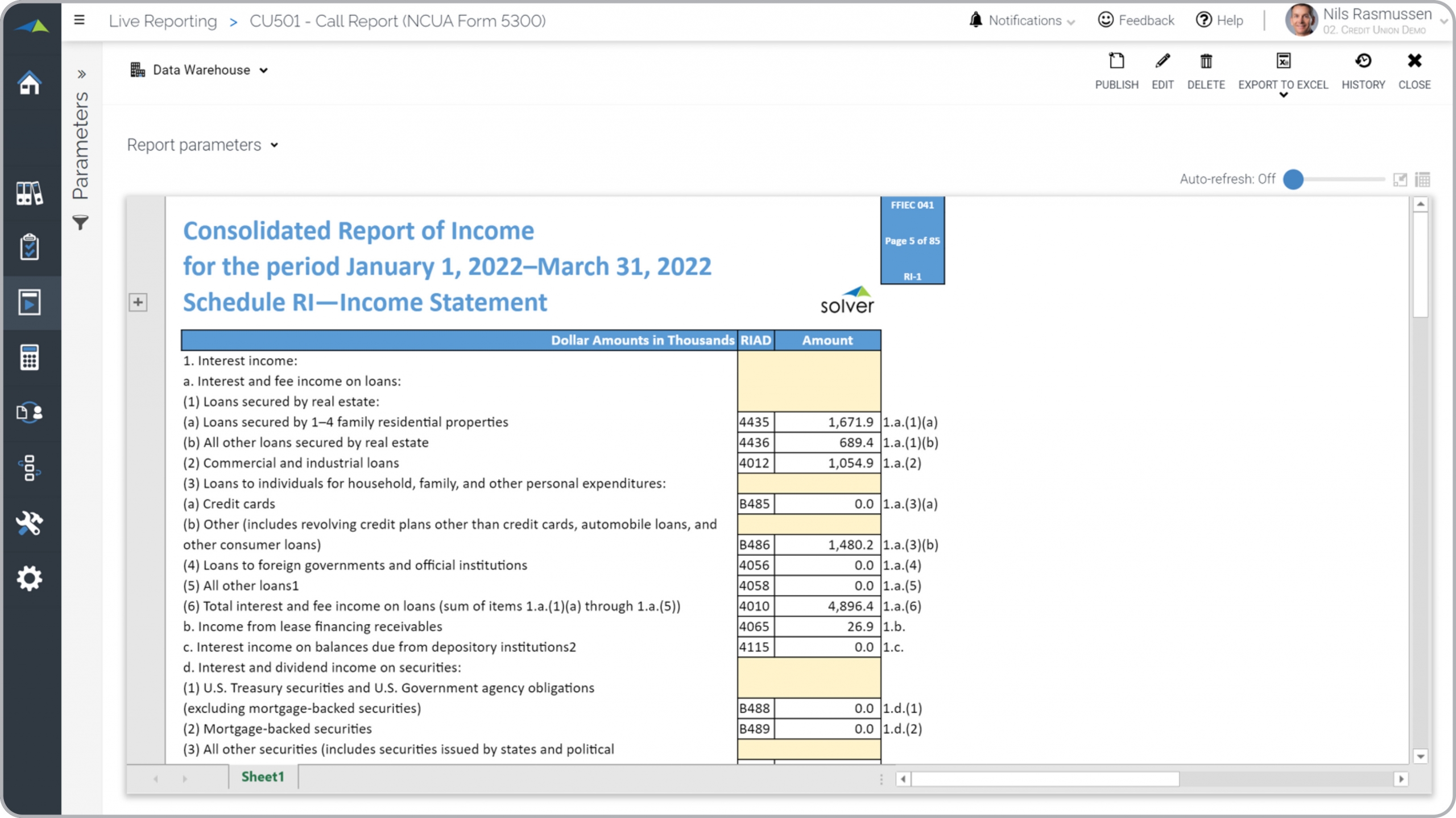Form 5300 Template for NCUA Call Reporting
What is
a
Form 5300 Template for NCUA Call Reporting
? The Consolidated Statement of Income (Form 5300) is a Call Reports and is used by accountants and compliance managers to submit quarterly data as per NCUA requirements. Some of the main functionality in this type of regulatory report is that it can both be used as an input form and as a formatted report ready to submit to NCUA. Any data that can be imported from the ERP system or other database will automatically be pulled into the form without having to be re-entered. Only the top portion of the form is visible in the screenshot. You find an example of this type of regulatory report below.
Purpose of
Form 5300 Call Report Templates Credit Unions use Form 5300 Call Report Templates to automate the input and submission process to NCUA. Because the template is part of a cloud-based system, users can log in and work on the report from anywhere. When used as part of good business practices in Accounting- and Compliance departments, a company can improve its processes and save labor costs, and it can reduce the chances that data entry mistakes occur.
Example of a
Form 5300 Call Report Template Here is an example of a NCUA Form 5300 Call Report with quarterly Consolidated Statement of Income data. [caption id="" align="alignnone" width="2560"]
 Example of a Form 5300 Template for NCUA Call Reporting[/caption] You can find hundreds of additional examples
here
Who Uses This Type of
Regulatory report
? The typical users of this type of regulatory report are: Accountants, compliance managers, CFOs.
Other Reports Often Used in Conjunction with
Form 5300 Call Report Templates Progressive Accounting- and Compliance departments typically use several Form 5300 Call Report Templates, along with internal income statements, balance sheets, cash flow reports, trial balances, transaction detail reports and other management and control tools.
Where Does the Data for Analysis Originate From? The Actual (historical transactions) data typically comes from enterprise resource planning (ERP) systems like: Microsoft Dynamics 365 (D365) Finance, Microsoft Dynamics 365 Business Central (D365 BC), Microsoft Dynamics AX, Microsoft Dynamics NAV, Microsoft Dynamics GP, Microsoft Dynamics SL, Sage Intacct, Sage 100, Sage 300, Sage 500, Sage X3, SAP Business One, SAP ByDesign, Acumatica, Netsuite and others. In analyses where budgets or forecasts are used, the planning data most often originates from in-house Excel spreadsheet models or from professional corporate performance management (CPM/EPM) solutions.
What Tools are Typically used for Reporting, Planning and Dashboards? Examples of business software used with the data and ERPs mentioned above are:
Example of a Form 5300 Template for NCUA Call Reporting[/caption] You can find hundreds of additional examples
here
Who Uses This Type of
Regulatory report
? The typical users of this type of regulatory report are: Accountants, compliance managers, CFOs.
Other Reports Often Used in Conjunction with
Form 5300 Call Report Templates Progressive Accounting- and Compliance departments typically use several Form 5300 Call Report Templates, along with internal income statements, balance sheets, cash flow reports, trial balances, transaction detail reports and other management and control tools.
Where Does the Data for Analysis Originate From? The Actual (historical transactions) data typically comes from enterprise resource planning (ERP) systems like: Microsoft Dynamics 365 (D365) Finance, Microsoft Dynamics 365 Business Central (D365 BC), Microsoft Dynamics AX, Microsoft Dynamics NAV, Microsoft Dynamics GP, Microsoft Dynamics SL, Sage Intacct, Sage 100, Sage 300, Sage 500, Sage X3, SAP Business One, SAP ByDesign, Acumatica, Netsuite and others. In analyses where budgets or forecasts are used, the planning data most often originates from in-house Excel spreadsheet models or from professional corporate performance management (CPM/EPM) solutions.
What Tools are Typically used for Reporting, Planning and Dashboards? Examples of business software used with the data and ERPs mentioned above are:
- Native ERP report writers and query tools
- Spreadsheets (for example Microsoft Excel)
- Corporate Performance Management (CPM) tools (for example Solver)
- Dashboards (for example Microsoft Power BI and Tableau)
Corporate Performance Management (CPM) Cloud Solutions and More Examples
September 4, 2021
TAGS:
Reporting,
Solver,
report writer,
Microsoft,
template,
practice,
Acumatica,
Netsuite,
Finance,
credit union,
planning,
GP,
fintech,
Business Central,
excel,
ax,
forecast,
Budget,
Dynamics 365,
budgeting,
bank,
Cloud,
Software,
Tableau,
SAP,
example,
best,
input,
Sage,
BC,
D365,
NAV,
Intacct,
financial institution,
CPM,
report,
branch,
SL,
Management,
dynamics,
Power BI,
regulatory,
Call Report,
database,
consolidated report of income,
NCUA,
5300,
National Credit Union association,
form 5300

